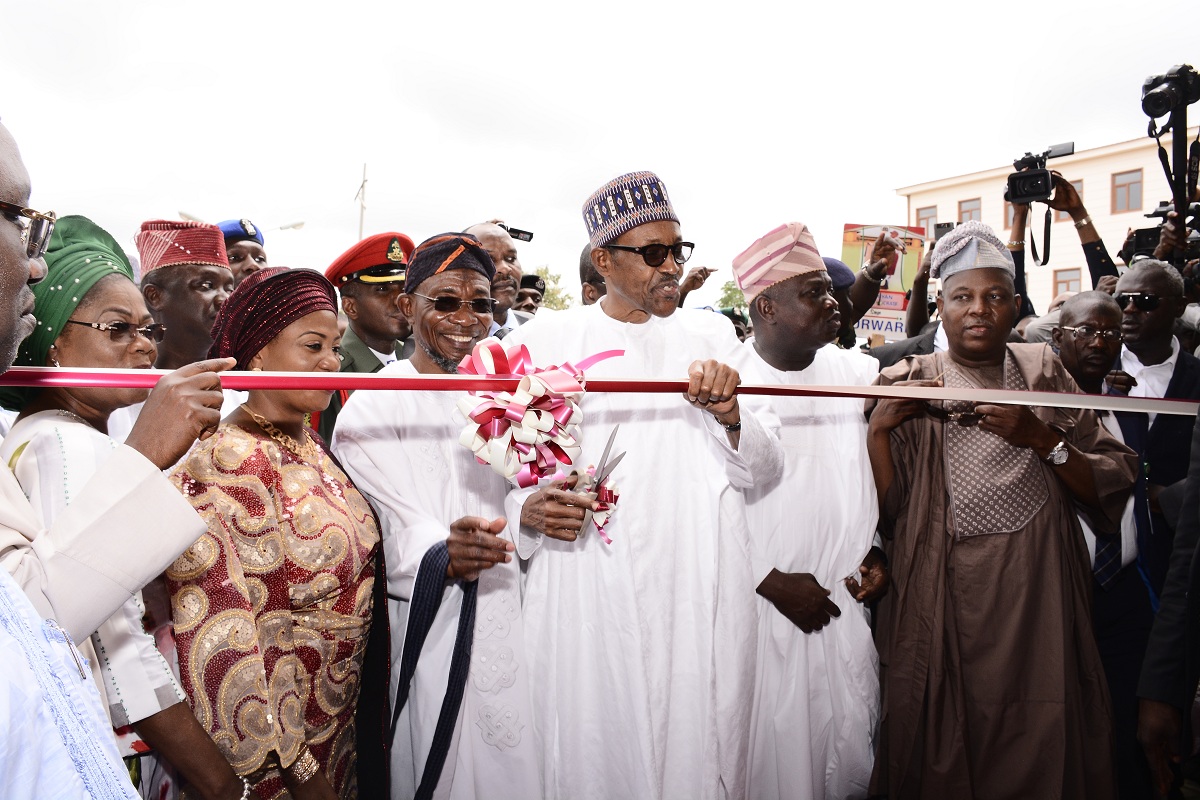
Osun: Where The Mind And The Body Are Being educated – Niyi Akinnaso
On Thursday, September 1, 2016, President Muhammadu Buhari chose to visit Osun among eleven states celebrating the silver jubilee of their creation in 1991. He did so for a number of reasons. The public script focused on his visit to some newly built elementary, middle, and high schools, capped by the inauguration of the Osogbo Government High School.

The occasion was my third visit to the same school since the commencement of its construction. Having visited many other secondary schools in the country, I concur with Mohammed Haruna that, in terms of learning space and facilities, Osogbo Government High School “must be one of the largest, most beautiful and most well equipped secondary schools in the country” (“Education: Aregbesola as an exemplar”, The Nation, September 8, 2016). It is a 3000 student capacity school, divided into three wings, each housing 1000 students. In addition to three principals, each manning a wing of the school, there is an overall supervising principal. Overall, the school has 72 classrooms, a 1000 capacity hall, a large ICT room, a spacious library, and various playing grounds.
So far, 13 mega High Schools of the same size have been completed or are almost completed. Adapting a similar template to elementary and middle schools, 28 Elementary Schools have been completed or renovated, each with a capacity of 900 pupils, while 22 Middle Schools have been completed, each with a capacity of 1000 students.
The underlying script for the President’s visit, however, is the fascination with the progress of Aregbesola’s primary and secondary education project in Osun, especially the state’s Home Grown School Feeding programme, which provides a reference point for a similar programme by other states and even by the Federal Government. Intended to provide a nutritious hot meal for over 24 million primary school children and, in the process, create over one million new jobs and boost the local economies across the country, the Federal Government’s school feeding programme was launched in June, 2016, as one of five projects under the N500b Social Investment Plan.
It will be recalled that after flagging off the Federal Government’s HGSF programme, a federal delegation visited Osun State in July to understudy the successful implementation of the state’s school feeding programme, styled O’MEALS. Many other states, including Kaduna, which flagged off its own programme in January, 2016, have equally visited Osun.
Osun remains the only one among 13 participating states in the pilot HGSF programme in 2005. Aregbesola resuscitated the programme in 2012, and it has been running uninterrupted ever since. Today, nearly 300,000 pupils are served one hot meal per school day by over 3000 food vendors. In addition to improving the nutritional and health status of the pupils, the programme has contributed directly to increased enrollment, which has nearly doubled since 2012, when 155,318 pupils started with the programme.
The multiplier effects of the programme are noteworthy. It has generated employment and created wealth not only for food vendors, but also for farmers, food produce sellers, and transporters. In addition to improving the nutrition of school children, who are its direct beneficiaries, the programme also enhances the nutrition of the immediate community of the food vendors, who are empowered to provide catering services in their respective communities.
In the year in which Aregbesola began the school feeding programme, he also initiated a physical education programme, focusing on calisthenics, with the assistance of a Cuban duo, Francis Rodriguez and Raiza Guerra. Calisthenics are physical exercises, using gross motor movements often to attain interesting rhythmic formations with others in a group. In addition to improving psychomotor skills, such as balance, agility, and coordination, calisthenics also helps to achieve group cohesion and discipline.
The Cuban duo initially trained a total of 8,000 athletes drawn from 24 schools and 60 coaches from the nine federal constituencies in the state. The group that performed four years ago, during the 21st anniversary of the creation of Osun, was drawn from this pool. The coaches trained by the Cubans were the ones who trained the next generation of pupils, who performed to wild applause during the commencement of the state’s 25th anniversary celebrations on Saturday, August 27, 2016.
The Osun calisthenics programme is integral to the reorganisation of the education system in Osun as it helps in the pupils’ physical development. As Aregbesola emphasized in his speech, “the calisthenics programme is not only an out-of-school sports activity but a lifestyle-change project for building a new generation of students who are physically fit, mentally sound and socially well-adjusted”. He added that calisthenics also helps to inculcate “the values of unity, harmony, discipline, teamwork, hard work and creativity into the school children”.
It is important to stress that school construction, school feeding, and calisthenics training are ongoing in Osun, despite dwindling resources and unjustified criticism leveled against Aregbesola’s education programme. Today, the worthlessness of the criticisms is brought into sharper focus by the national and international profile of the programme.
It is important to recall some of those criticisms, if only to highlight their wrongheadedness. For example, when Aregbesola reclassified schools into Elementary School (primary grades 1-4), Middle School (primary grades 5&6 plus JS 1-3), and High School (SS grades 1-3), he was roundly criticized for violating the 6-3-3-4 education policy. Yet, the Osun education system remains based on the 6-3-3-4 education policy, while the new classification was done mainly to create room for feeding children in elementary grades 1-4, that is, 6-9 year old pupils, who need a healthy head-start in school, and to separate them from other primary pupils, who will not be fed in school.
Similarly, the merging of schools, in order to maximise the benefits of infrastructural development and achieve cost effectiveness, was grossly misunderstood, due to false reporting, as mergers of Muslim and Christian Schools. Yet, the schools were never merged across religious boundaries. What was often ignored in the criticisms is the predominance of Muslim students even in many Christian schools in the state. The concocted hijab crisis found a basis in these distortions. In Baptist High School, Iwo, for example, where the hijab crisis was planted and nurtured to death, well over 60 per cent of the student population is Muslim.
The school feeding programme was not spared from criticism. Some said it was a fluke, while others ridiculed the government for some items on the menu, such as cocoyam, without caring to find out about its nutritive value.
Worse still, when political opponents saw the calisthenics training sessions of the pupils in 2012, they immediately alleged that Aregbesola was training the youths as armed militias, who would be used to assist his state in seceding from Nigeria!
True, the reward for Aregbesola’s educational revival in Osun may take some time to manifest. Nevertheless, a solid foundation has been laid for successive administrations to build on.



